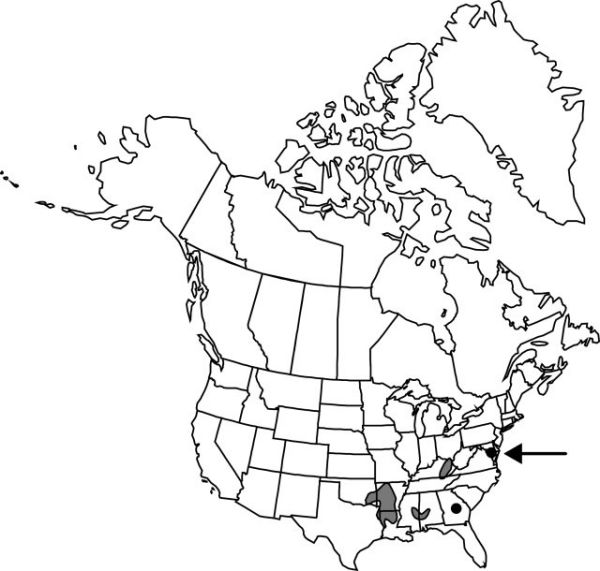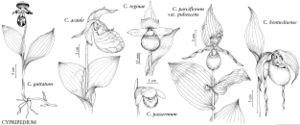Cypripedium kentuckiense
Phytologia 48: 426, fig. 1981.
Plants erect, 35–97 cm. Leaves 3–6, rather evenly spaced along stem, alternate, spreading; blade broadly ovate to ovatelanceolate or ovate-elliptic, 13–24 × 4.3–15 cm. Flowers 1–2; sepals greenish or yellowish, heavily spotted, striped, reticulately marked with dark reddish-brown or madder; dorsal sepal broadly ovate to ovate and elliptic, 61–126 × 24–65 mm; lateral sepals connate; synsepal 55–103 × 12–40 mm; petals spreading-deflexed, same color as sepals, spirally twisted, linear, 84–156 × 7–15 mm; lip ivory to pale-yellow, obovoid, (41–) 53–65 mm; orifice basal, 27–37 mm; staminode broadly ovoid, ovoid-cordiform, or ovoid-deltoid.
Phenology: Flowering Apr–Jun.
Habitat: Rich, mesic to dry, deciduous forests on well-drained alluvium and bases of slopes, mucky seeps
Elevation: mostly 0–400 m
Distribution

Ala., Ark., Ga., Ky., La., Miss., Okla., Tenn., Tex., Va.
Discussion
The brief nomenclatural history of Cypripedium kentuckiense is remarkably confused. The plant was originally described, without Latin diagnosis, as C. daultonii Soukup; this nomen nudum came into general usage prior to Reed’s publication. Subsequently, an earlier name, C. furcatum Rafinesque, was proposed as conspecific, but Rafinesque’s description is not adequate for a positive determination.
Cypripedium kentuckiense is very distinctive. In addition to the very large flowers and pale coloring of the lip, the form of the orifice is unique. In related species the orifice is a restricted opening in the adaxial surface of the lip; in C. kentuckiense the orifice replaces the basal portion of the adaxial surface, the sides of the lip terminating abruptly at the orifice without curving toward the horizontal. In herbarium specimens this detail is obscured, but the cavernous nature of the orifice is emphasized by the adaxial surface descending from the apical margin of the orifice toward the apex of the lip; the obovoid lip appears to hang from the margin of the orifice, and the lip is not particularly slipper-shaped. In contrast, in related species, the adaxial surface of the lip surrounds the orifice and extends forward toward the apex, forming a more convincing slipper. These distinctions hold virtually throughout the known populations of C. kentuckiense; only in two Arkansas populations is the lip form suggestive of related species. The Arkansas populations may reflect very limited introgression from C. parviflorum var. pubescens.
Selected References
None.
